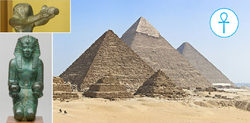- Retour accueil
- Vous êtes ici : Blog The Pyramids of the Cold The Pyramids of the Cold Section 28 • The Elephantine Triad deification of the Biosand filter
The Pyramids of the Cold Section 28 • The Elephantine Triad deification of the Biosand filter
Publié par Bruno Coursol dans The Pyramids of the Cold le 18/11/2022 à 18:15

We'll see in this Section that just like the Memphis Triad is representing the creation of evaporative cold by associating three deities who were the deifications of pressurized water (Ptah) + pressurized dry warm air (Sekhmet) + the fog nozzle of the Great Pyramid of Giza (Nefertem, see previous Section 27), the Elephantine Triad is all about the glorification of the operation of a biosand filter. The ram-headed "Great Potter" water god Khnum is the deification of this biosand filter: the ram metaphor is about the rammed earthed used by a potter into a mold; just like earth (sand) is used into a sand filter. Family biosand filter photograph from: https://wiki.lowtechlab.org/wiki/Water_-_Biosand_Filter#
The Pyramids of the Cold Section 28 • Hapi and the Elephantine Triad deification of the biosand filter
In summary: this Section will correct a wrong interpretation of god of the Nile Hapi I've been doing for the last past months, saying that the water used to power up the Great Pyramid was coming from the Nile. If every single ancient Egyptian deity is nothing but a metaphorical glorification of scientific knowledge and accomplishment, there is no reason for Hapi to be different: the water circulating inside the Pyramid wasn't coming from the Nile, but its meandering movement inside the structure would have make it looked like the Nile meandering through the whole Egypt. This is why the Great Pyramid had been associated with Egypt itself, and why the Lower and Upper Pyramid had been glorified into Lower and Upper Egypt.
On that matter, I have no other choice but to switched back to my first assumption that rainwater was used instead of water from the Nile. If ancient Egyptians would have used water from the Nile, they would have no problem supplying about 200 liters of water every 15 minutes or so, and they wouldn't have needed the King's chamber. That chamber was the mandatory collecting tank required in every single rainwater harvesting system.
We'll see that the annual inundation god of the Nile Hapi wasn't the One releasing its own waters from his cave, but that it took the combined goddesses Satis and Anuket to accomplish the release of the waters. If these two goddesses were part of the Elephantine Triad along with god Khnum, it is because this extremely important water god was the beneficiary of these waters, and because this god who is "molding" lives from earth is also really about earth: water god Khnum is the deification of the biosand filter, like the one which is still in place today in the Bent Pyramid, but which nobody is talking about, and which is not even represented in "official" draws of the internal layout of this Pyramid.
We'll see that because of his true nature, Khnum is indeed associated with drinking water, even if as a biosand filter his real function in the Great Pyramid was only to provide softened water with high microbial stability for the evaporative cooling process.
Finally, we'll see that ancient Egyptians used in Satis and Anuket the exact same active and inactive aspects in their metaphorical representation of the water supplying valve of a biosand filter: when Satis is described as "running like an arrow" and releasing Hapi's waters, Anuket is described as a "vagina" and is showing water plumes other her head.
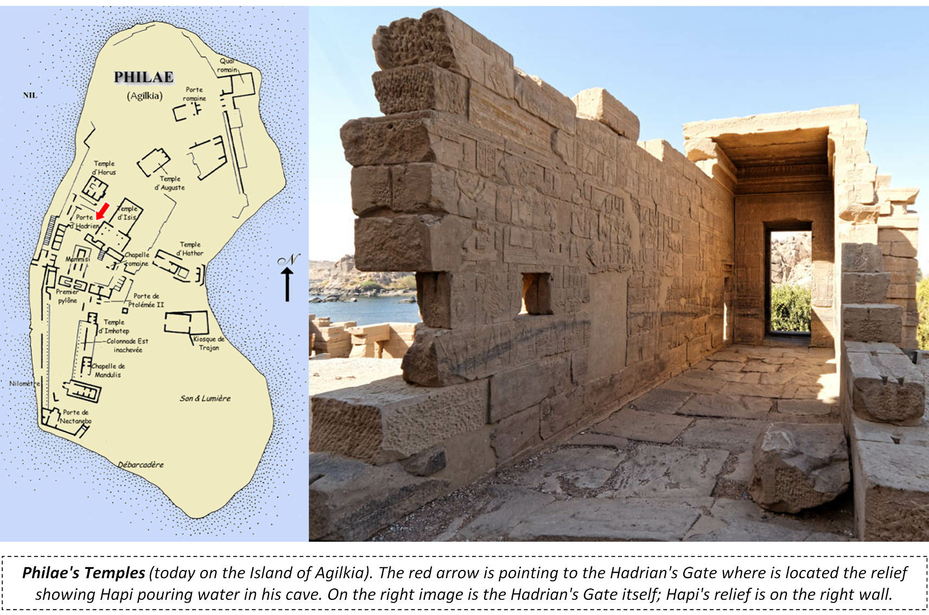
The temples of the ancient island of Philae, now rebuilt on the Island of Agilkia; the red arrow is pointing to the Hadrian's Gate where is located the relief showing Hapi in his cave. Image by Gérard Ducher: "In the 1960s, every building was dismantled, and transported to the nearby island of Agilkia, situated on higher ground some 500 m away": https://commons.wikimedia.org/w/index.php?curid=503180
Hadrian's Gate photograph: http://www.temples-egypte.net/philae/porteHadrien.html
28.01 The Elephantine Triad deciphering starts with Hapi's representation in the Isis Temple of Philae
We'll see in this Section that just like the Memphis Triad is representing the creation of evaporative cold by associating three deities who were the deifications of the pressurized water creation (Ptah) + pressurized dry warm air (Sekhmet) + a fog nozzle (Nefertem, see previous Section 27), the Elephantine Triad is all about the glorification of the operation of a biosand filter (Khnum), and the control of its water supply with active Satis "who runs like an arrow" and inactive Anuket "who looks like a vagina".
But to understand the Elephantine Triad, we first need to get back to Hapi, the god of the annual inundation of the Nile, and we'll start with his representation in the northern wall of the Hadrian's Gate, just next to Philae's Isis temple, now on the island of Agilkia.
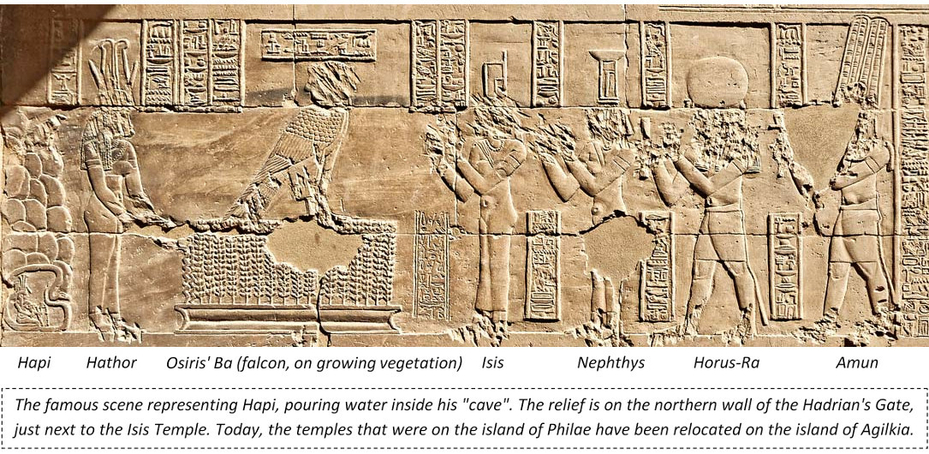
http://www.temples-egypte.net/philae/hadrien/paroiNord/registreMilieu.html
28.02 Hapi and his cave are at ground level, not underwater
Academic interpretations of the relief showing Hapi pouring water in a "cave" or "cavern", at the small Isis temple at Philae, which is a unique and extraordinary artistic representation of this god, is that he is supposed to be underwater and somehow "creating" the waters of the inundation of the Nile.
But it just can't be right, because as seen on the above image of the scene, the cave and the entire structure of piled up blocks above it, are in the exact same level than all the other gods in human shape: Hapi is at ground level, he is not underground or underwater. Both Hapi and his cave are at ground level.
"Hapi (Ancient Egyptian: ḥʿpy) was the god of the annual flooding of the Nile in ancient Egyptian religion." https://en.wikipedia.org/wiki/Hapi_(Nile_god)
28.03 Hapi's cave being "under the Sun" confirms the idea that it is not underwater, nor it is underground
This idea that Hapi's cave is not located underground or underwater, is reinforced by some ancient Egyptian texts which are saying that Hapi lives in a cave "never seen by anyone" and that this cave is "under the sun"; but if the cave is under the sun, it clearly means that the cave is not underground nor it is underwater.
If it has to be pointed out the fact that the cave cannot be seen by anyone, it is actually suggesting that it normally shouldn't be that way: no none would have to say that an underwater cave wouldn't be seen by anybody, it is just what is expected from such a cave.
If it is clearly specified that the cave cannot be seen by anybody, it is not a cave, but some kind of structure specifically designed so that nobody would ever have to see or to get in.
"Hapi lives in the distant south, in a cave never seen by anyone under the sun and pours the water of the Nile from her/his carafes." http://egyiptom.freeweb.hu/english/gods_hapi.html
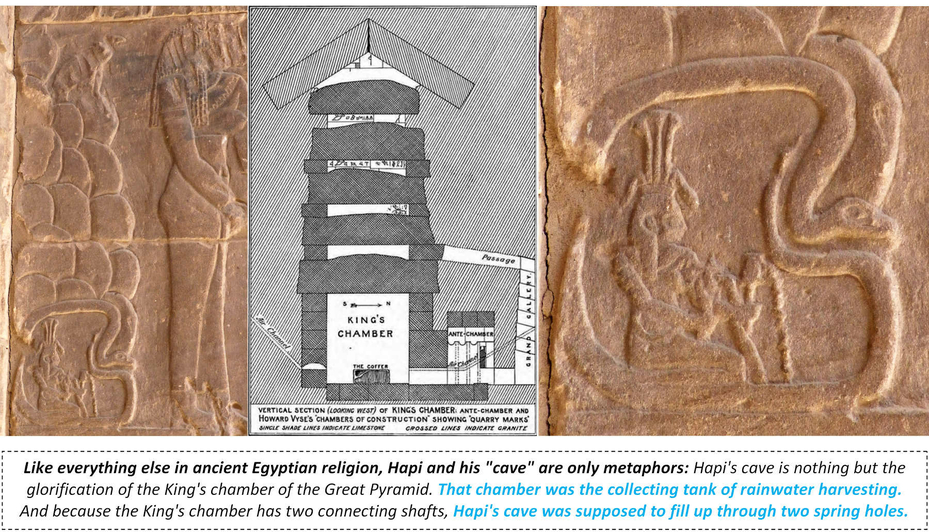
Original photograph of the unique representation of god of the Nile Hapi, pouring water inside his "cave", on a relief in the Hadrian's Gate, next to the Isis temple that was on the island of Philae, by Manon Y. Schutz: https://twitter.com/manonyschutz/status/1349673443969658880
Original draw of the King's chamber of the Great Pyramid of Giza: "Great Pyramid Passages and Chambers, Volume 1 (1910 edition). By John and Morton Edgar. The Edgars were associates of Charles Taze Russell and wrote this treatise in defense of Russell's views on the prophetic symbolism of the Great Pyramid of Gizeh in Egypt." https://archive.org/details/GreatPyramidPassagesVol11910Edition/page/n63/mode/1up
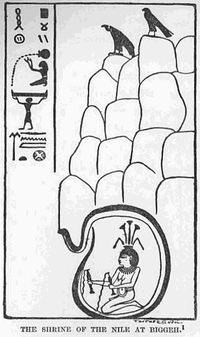
28.04 The artificial design of Hapi's cave
What is very surprising about this draw that have been made of the relief, except the fact that it is inverted, is how badly the shape of the snake is rendered: it is like the author wanted to transform the very peculiar and artificial original shape of the snake into a completely dull and natural rounded shape. But maybe it was made by accident, and there was no intention to hide or disguise anything; the fact that the drawing is inverted should reinforce this idea.
But the fact is that if you look closely to the shape of the snake, hence the shape of Hapi's cave, you simply can't miss the artificial design of the whole thing.
Very poorly and inverted draw of the relief, reproduced in "The Project Gutenberg EBook of History Of Egypt, Chaldæa, Syria, Babylonia, and Assyria, Volume 1 (of 12), by G. Maspero: Reproduced from a bas-relief in the small temple of Philae, built by Rajan and his successors. […]. By a mistake of the modern copyist's, his drawing faces the wrong way." https://www.gutenberg.org/files/19400/19400-h/19400-h.htm
28.05 Hapi's cave is a representation of the King's chamber of the Great Pyramid of Giza
If Hapi's cave does look artificial in the original relief, it is because the "cave" is actually really artificial: the cave is a construction, a structure made by man, and which is under piled up blocks of rock. That man made structure "cave", which is filled up with water is nothing else than the King's chamber of the Great Pyramid: the artificial shape of the cave is mimicking the original design of the chamber, in particular the little passage that leads to it, and the piled up blocks of the relief are mimicking the blocks set onto the King's chamber, whether they are about the piled up granite beams of the "relieving chambers" or a representation of the limestone blocks of the pyramid itself. In summary, Hapi's cave is the main water tank of the Great Pyramid: it is a representation of the King's chamber.
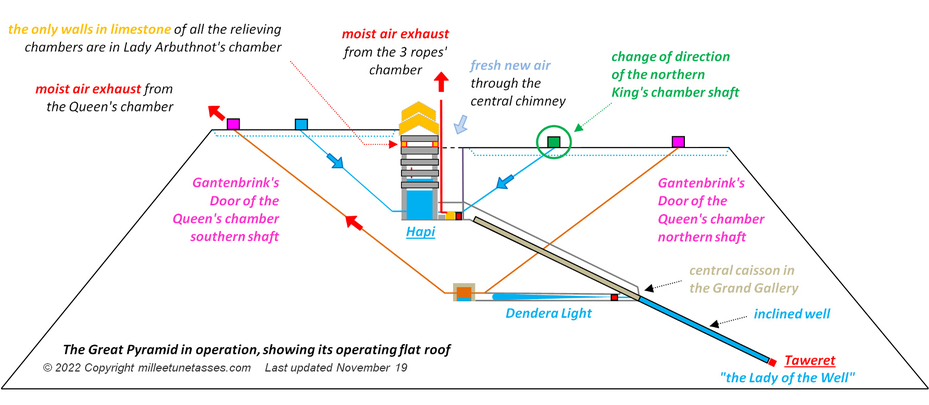
Because the Great Pyramid wasn't finished at the time of its operation and the presence of a temporary more or less flat roof, the Gantenbrink's Doors were real hatches opening to the exterior of the pyramid. Gantenbrink's Doors were real "doors".
28.06 The Gantenbrink's Doors were hatches opening on the flat roof of the operating Great Pyramid
It has to be pointed out that at the time of the operation of the Great Pyramid for evaporative cold production, like I've said many times, the pyramid wasn't finished and there was what could be assimilated to a flat roof.
That flat roof explains that Hapi is described as being "under the Sun".
Many elements are pointing to the flat roof design of the Great Pyramid, when it was in operation. The elevation level of that flat roof was probably set by the Gantenbrink's Doors that would have been more like hatches that real "doors", and would coincide with the elevation level of the Lady Arbuthnot's chamber, where the granite walls of the "relieving" chambers are suddenly replaced by usual limestone blocks.
1 • The mysterious Gantenbrink's Doors closing the upper part of the Queen's chamber shafts
2 • The northern King's chamber shaft change of direction
3 • The walls of the Lady Arbuthnot's chamber which are made of limestone, while all the other walls of the "relieving chambers" are made of granite, just like all the beams of the floors and ceilings of these chambers.
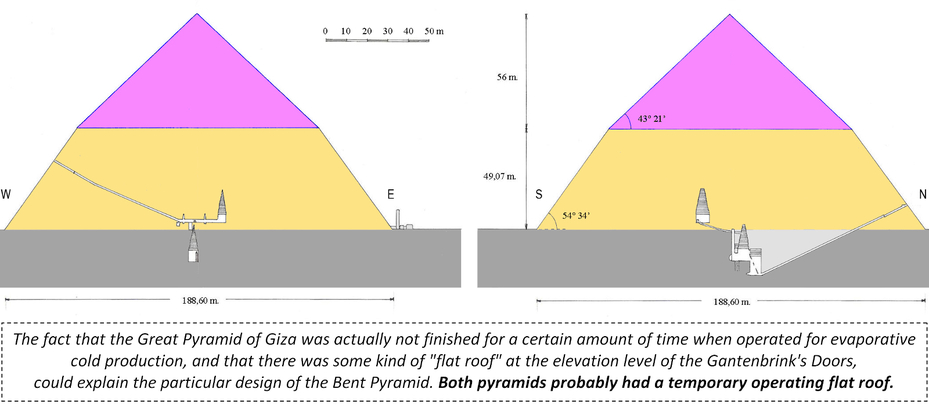
Bent Pyramid internal layout by Franck Monnier: https://fr.m.wikipedia.org/wiki/Fichier:Bent_Pyramid_substructure_2.png
28.07 The flat roof design probably already used in Sneferu's Bent Pyramid
Actually the Great Pyramid would have looked like something close to the first half of the Bent Pyramid; and of course, the fact that this pyramid is "bent" in the first place, is most probably explained by the same necessity of using that "flat roof".
28.08 Hapi lives in the distant south and under the Sun
That flat roof also explains why Hapi was described as "living under the Sun": there probably was some kind of access to the Grand Gallery through something that might have resemble to a "central chimney" that would have allowed fresh air as well as the crewmembers of the Hauling beetle to get into the Gallery.
"Hapi lives in the distant south, in a cave never seen by anyone under the sun and pours the water of the Nile from her/his carafes." http://egyiptom.freeweb.hu/english/gods_hapi.html
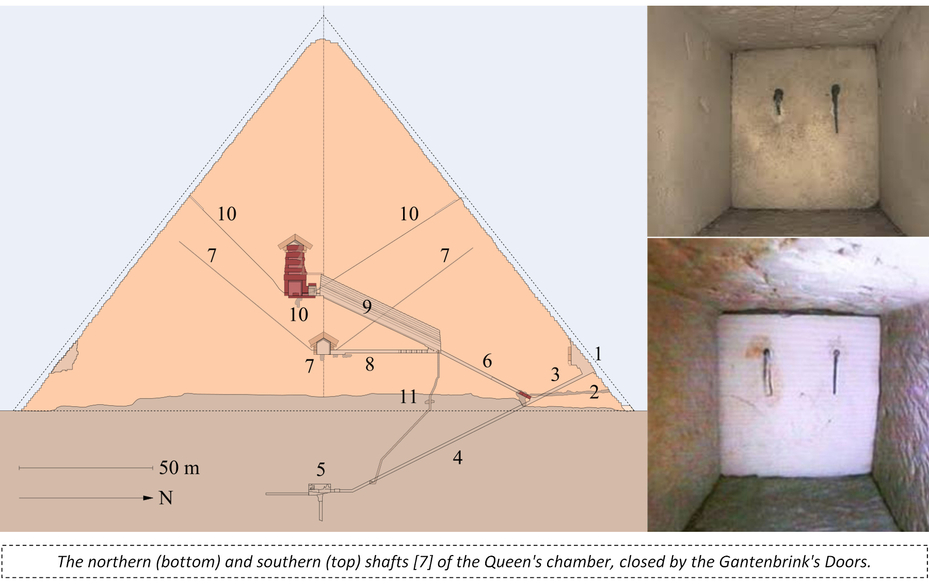
Elevation diagram of the interior structures of the Great Pyramid.10 shows the King's Chamber and its "star shafts".7 shows the Queen's Chamber and its shafts: https://en.wikipedia.org/wiki/Star_shaft#/media/File:Great_Pyramid_S-N_Diagram.svg
"This find in the northern shaft, coupled with last week's discovery ... in the southern shaft, represents the first major new information about the Great Pyramid in more than a century." - Zahi Hawass to https://www.cheops.org/ Images at: https://www.pyramidofman.com/shafts/
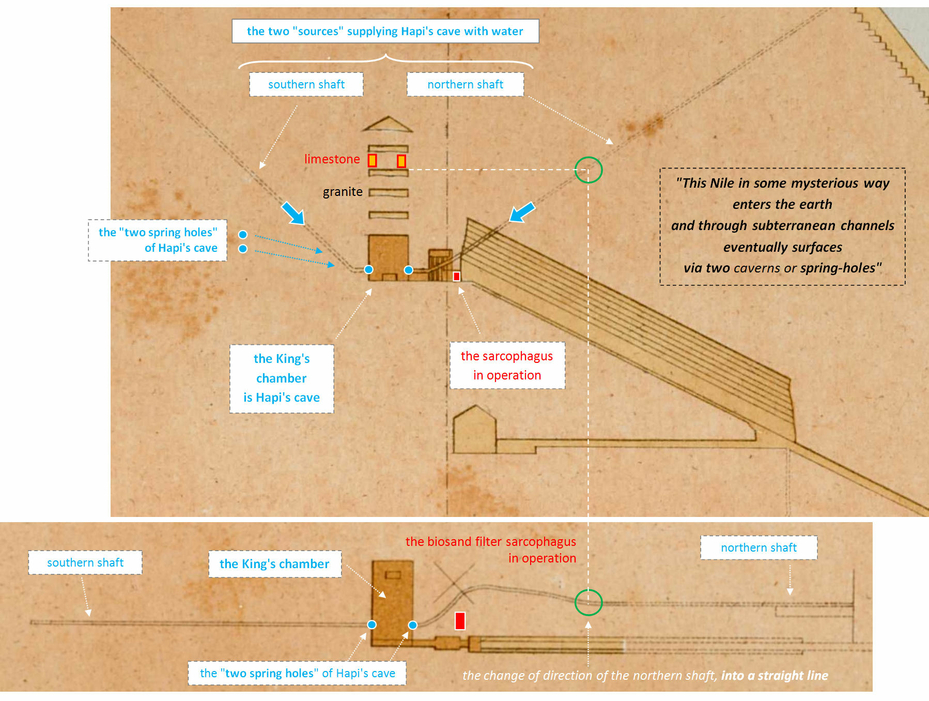
The strange trajectory of the northern King's chamber shaft of the Great Pyramid of Giza.
Original images thanks to the Bibliothèque nationale de France. "Histoire de l'art égyptien d'après les monuments, depuis les temps les plus reculés jusqu'à la domination romaine" 1858-1879, by Émile Prisse d'Avennes (1807-1879). © Bibliothèque nationale de France, département Réserve des livres rares : http://passerelles.bnf.fr/grand/pas_2457.htm
28.09 Hapi's cave and its two spring holes are about the King's chamber and its two shaft openings
One of the most interesting parts of the mythology about Hapi is how were created the waters of the Nile: ancient Egyptians believed that inside their paradise, the "field of the blessed" in the underworld, was running a river which came from the heaven "in a mysterious way" and was filling Hapi's cave passing through two spring holes.
Like everything else, it is a very cute story which only originates in the Great Pyramid and in particular in the King's chamber itself. Because these two "subterranean channels" and two "spring holes" are simply about the northern and southern shafts of the chamber.
"...the Egyptians held of the origin of the Nile and the connection of its sources with the Egyptian paradise in the netherworld. According to these "the fields of the blessed" which is the Egyptian paradise, were encircled by "a river" (itru) that went forth from heaven. In a mysterious way that river reached the surface of the earth, through two spring holes below the first cataract between Elephantine and Philae and emerged as the Nile. This idea is pictorially represented in a relief in a small island near Philae, at the first cataract. Under a mass of rocks, the god of the Nile, Haapi, protected by a serpent, is pouring out of two vases in his hands, symbolising the two sources of the Nile. Thus the Nile was merely the earthly prolongation of the heavenly "river" (itru) and the two spring-holes beneath the cataract only marked the place where it came out to the surface."
(p. 165. "The Story of Paradise." Abraham S. Yahuda. The Accuracy of the Bible. London. William Heinemann. Ltd. 1934) http://www.bibleorigins.net/QwertyNileCavernSourceAswan.html
"This Nile in some mysterious way enters the earth and through subterranean channels eventually surfaces via two caverns or spring-holes near the last Nile cataract in the vicinity of Aswan (Greek Philae). The Nile then flows upon the earth's surface till it reaches the Mediterranean Sea where it magically rejoins the sky." http://www.bibleorigins.net/QwertyNileCavernSourceAswan.html
28.10 The northern (Hap-Meht) and southern (Hap-Reset) shafts of the King's chamber
Most probably these two northern and southern shafts are the origin of Hap-Reset (the god of the South Nile) and Hap-Meht (the god of the North Nile).
"...the Egyptians believed that the Nile rose in the First Cataract, the Qerti, or "Double Cavern," and the Nile of the South was to them that portion of the river which extended from Elephantine to a place some little distance north of the modern Asyut. The god of the South Nile has upon his head a cluster of lotus plants whilst he of the North Nile has a cluster of papyrus plants, the former is called HAP-RESET, and the latter HAP-MEHT. When the two forms of Hep or Hapi are indicated in a single figure, the god holds in his two hands the two plants, papyrys and lotus, or two vases, from which he was believed to pour out the two Niles...the source of the waters of the Nile-god was unknown." http://www.bibleorigins.net/QwertyNileCavernSourceAswan.html
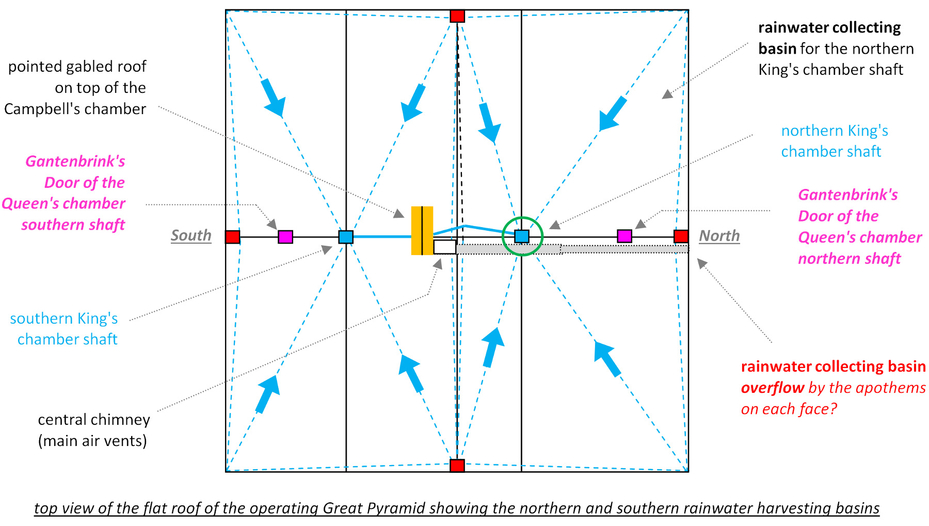
28.11 Hapi is just another metaphor: the water used to power up the Pyramid certainly wasn't water from the Nile
We've already seen that ancient Egyptians assimilated the internal layout of the Great Pyramid into their Underworld, hence the famous "mysterious and secret cavern of the Underworld, where was performed the "sacred act of Hauling" (Section 11); but we've also seen that they assimilated that same layout into the whole Egypt country, hence the Upper and Lower Egypt which are corresponding respectively to the Upper and Lower Pyramid, based on the ground level that was the upper platform of the Gallery.
When it is mentioned that Hapi lives "in the distant south", it is not really about Egypt, but rather about the southern part of the Great Pyramid. Because the King's chamber was located in the distant south of the operating Pyramid, Hapi has been described as living in the distant South of Egypt.
And suddenly it struck me: if all ancient Egyptian gods are nothing but metaphors, why would Hapi be different?
And in my opinion, he is not: Hapi is just another metaphor. Let me put it this way: the waters of the Nile are just another metaphor. There is no water from the Nile getting inside the Pyramid; the water that was used, just looked like the Nile river meandering through Egypt country.
The problem is that I've made the exact same mistake than egyptologists are doing: I didn't really understood the metaphor about Hapi.
Just like there was no real hippopotamus at the bottom of the inclined well, there was not really water from the Nile in the Great Pyramid: the water used was just looking like the Nile, getting in the pyramid through the King's chamber shaft(s), then the chamber itself, the filter, the central gutter of the Gallery, the inclined well and finally the evaporative passage before being forced outside of the pyramid through the Queen's chamber shaft(s).
This "voyage" of meandering water in every parts of the pyramid is the reason why they used the Nile metaphor, but this is just a metaphor: in my opinion the water was simply rain water.
28.12 Nile water and salt deposits vs. rainwater harvesting
If water from the Nile would have been used, especially at the time of the annual inundation, it would have been charged with huge amounts of silt, that would have rapidly created silt deposits in the chamber: why would they have used water from the Nile?
And more importantly, why would they have needed a King chamber?
If only about 200 liters of water were needed every 15 minutes, and you have tens of thousands of workers available at any time, you wouldn't need a huge water tank this size.
The only reason for the King's chamber to have been built in the first place, is that they used rain water like I first thought at the beginning of the study (posts I've written just before "the Pyramids of the Cold").
If this is right, the King's chamber was nothing less than the main reservoir for the rainwater harvesting that took place on the flat roof of the Pyramid.
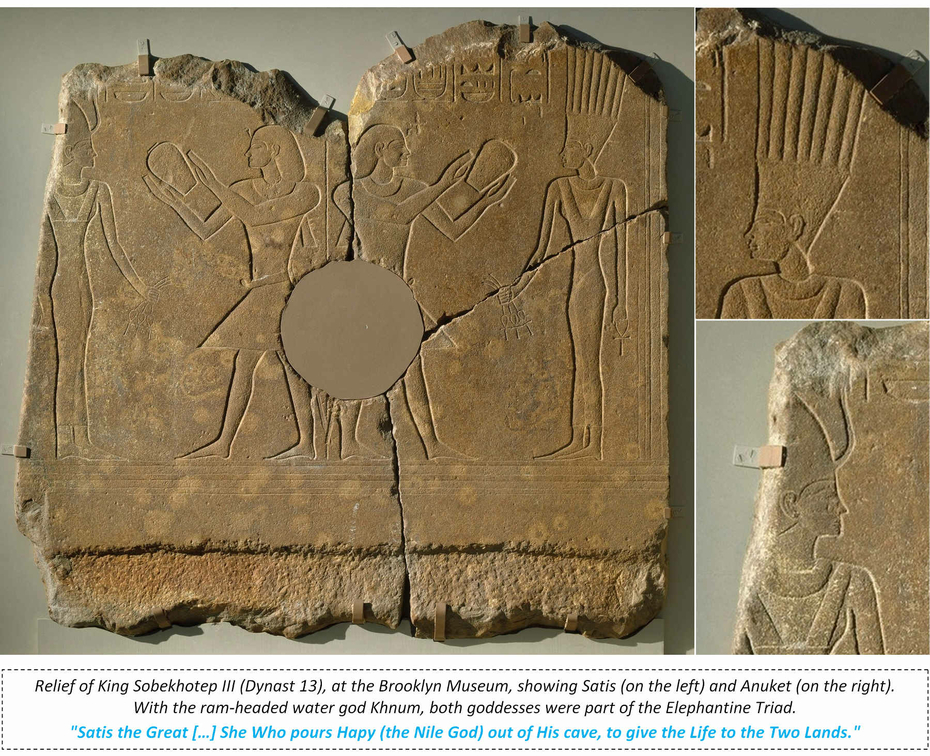
Relief of King Sobekhotep III (Dynast 13), at the Brooklyn Museum, showing the two goddesses Satis (on the left) and Anuket (on the right). "This relief depicts Sobekhotep III offering vessels to the goddesses Satis and Anukis (left and right, respectively). This was a common motif of temple decoration. The king, who theoretically conducts the cult’s rituals in every temple every day, offers to deities who in turn bless him and, through him, Egypt. Both goddesses extend to the king three “life” hieroglyphs (the ankh)." https://d1lfxha3ugu3d4.cloudfront.net/images/opencollection/objects/size4/77.194_SL1.jpg
28.13 Goddess Satis is the One "pouring Hapi out of his cave": Satis is releasing the waters
What is fascinating with Hapi and the waters of the Nile thing, is that the only representation of the god we have "in situation" is showing him in his cave, holding the two vases as representations of the two underwater rivers and the two spring holes, but that's it, there is nothing more: Hapi is simply represented in his cave and he stays in his cave.
In other words, Hapi's realm is that cave: the King's chamber.
And if it wasn't for another deity, goddess Satis, Hapi's waters would stay in the cave: Satis is the One who is "pouring" and releasing Hapi's waters.
“Satis the Great, the Lady of Sunu (Syene), the Eye of Ra, the Lady of the Sky, Queen of all the Gods, Rayt (/Raet, the female counterpart of Ra), the Great One in Senmet (Abaton, the highly sacred island of Osiris, located close to Philae), She Who pours Hapy (the Nile God) out of His cave, to give the Life to the Two Lands” https://www.facebook.com/AmentetNeferetEgyptianReligion/posts/sati-the-great-onethe-lady-of-sunu-syene-aswanthe-eye-of-rathe-lady-of-the-skyqu/3687454131283273/
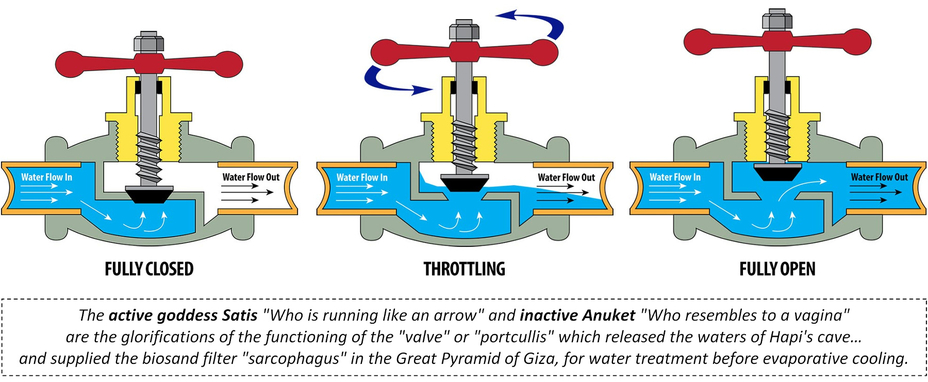
Tap water draws showing the active part of the valve (the "stem") and the inactive part (the "seat"). "Compression valves, also known as multi-turn valves, are usually globe valves. They feature a stem with a rubber washer on the end, which is attached to the valve handle. When turned, the stem moves into the cavity of the valve, compressing the washer against the internal seat and forming a seal." https://www.plumbingsupply.com/compression-vs-quarter-turn-stops.html
28.14 Anuket was compared to a vagina and was known as "She Who embrace"
Anuket is another goddess in whom ancient Egyptians projected sexual metaphors about her true nature, i.e. the inactive part of the controlling valve of the King's chamber; probably the most accurate metaphor about Anuket is comparing her with a "vagina", but the reference to "embrace" or "suckling" are almost as good.
"Her name means “embrace” and may have originally referred the embrace of the waters of the inundation. She was also depicted suckling the pharaoh during the New Kingdom, and became a goddess of lust during later periods. In this form, she gained association with cowrie shells, which resemble the vagina. The Festival of Anuket was held when the inundation began. People threw coins, gold, jewelry, and precious gifts into the Nile to please the goddess." https://ancientegyptonline.co.uk/anuket/
28.15 The Anuket "vagina" pierced by the Satis "running arrow"
Once you have deciphered Satis and Anuket separately, it becomes easy to understand the way they were supposed to interact: Satis "running like an arrow" was supposed to "pierce" into the Anuket "vagina"; and that is the perfect metaphoric representation of the functioning of a stem and seat system valve.
"Her name was originally written with the hieroglyph for a linen garment's shoulder knot (S29); this was later replaced by Anuket's animal hide pierced by an arrow (F29). She was also known by epithets, such as "Mistress of Elephantine" and "She Who Runs Like an Arrow", thought to refer to the flowing river current." https://en.wikipedia.org/wiki/Satis_(goddess)
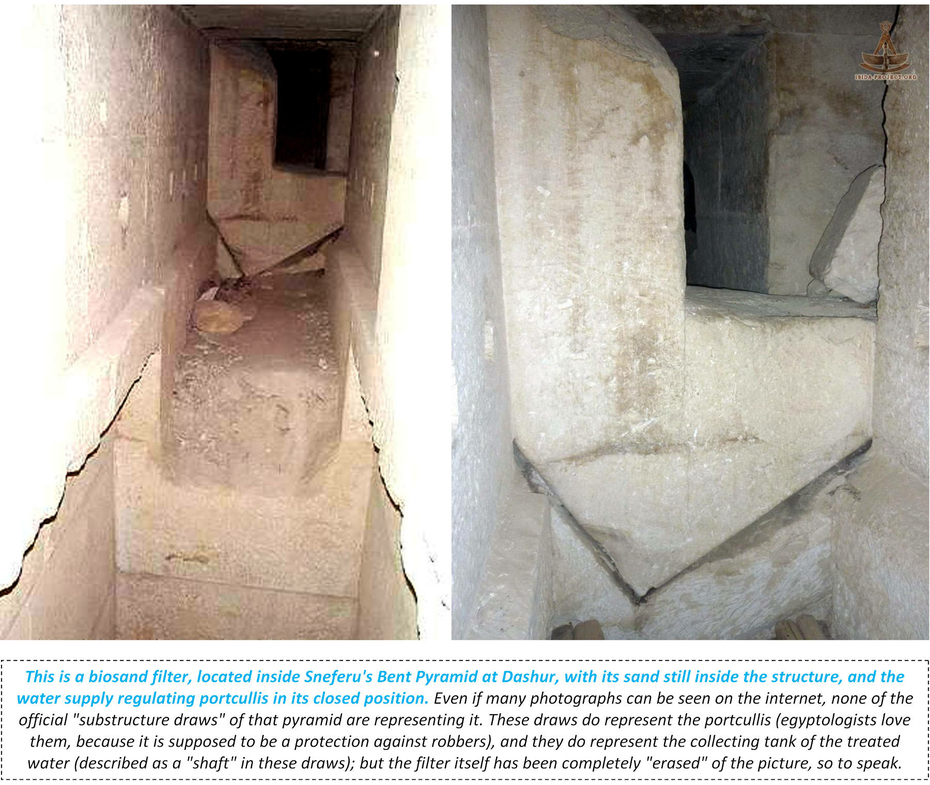
Left image: photograph of the interior of the Bent Pyramid, one of the three great pyramids built by king Sneferu (the founding pharaoh of the Fourth Dynasty of Egypt during the Old Kingdom). https://guardians.net/egypt/cyberjourney/dahshur/bentpyramid/bent_pyramid_interior.htm
Right image: Bent Pyramid of Sneferu at Dahshur, Western part of the Horizontal Passage with Portcullis, thanks to the ISIDA Project, Research Society on Ancient Artifacts: https://isida-project.ucoz.com/egypt_2012/dashur_bnt_corridor.htm#fw
28.16 The sand filter of the Bent Pyramid is perfectly showing the Satis and Anuket "run like an arrow" metaphor
I just don't know if the sand filter of Sneferu's Bent Pyramid was a biosand filter, or if it wasn't designed to be operated with a biofilm layer, but it is hard not to see it, even if the "official draws" of this pyramid, made by CNRS engineer Franck Monnier (both in 2007 and in 2016), are not showing it.
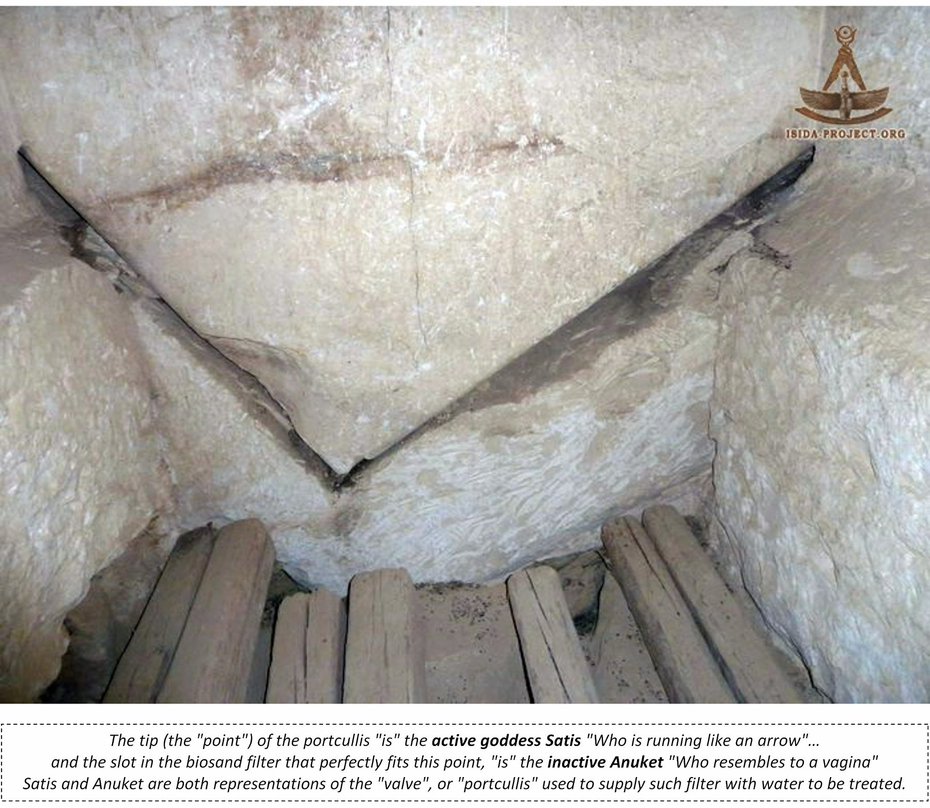
Image courtesy of ISIDA project: https://isida-project.org/egypt_2012/dashur_bent/corridor_w/p1160851.jpg
28.17 Satis "Who runs like an arrow" + Anuket "Who looks like a vagina" = the release of Hapi's water
Now, this Section is really getting interesting. We've seen that Hapi represents water which is imprisoned inside a structure which is the King's chamber of the Great Pyramid, and that this is goddess Satis of the Elephantine Triad who is the one actually releasing these waters.
We also know that not only Satis is said to be releasing the waters contained in Hapi's cave, but she is also described as "running like an arrow".
I don't know about you, but when I hear this, I immediately think of the functioning of a valve, with its moving part which is controlling the flow of water getting out of a water tank.
If you've already seen previous Sections about Isis and Nephthys, Wadjet and Nekhbet, or Osiris himself who was seen both as the "Great inert", "asleep" and "lethargic", and as the one who gave all his energy, force and power to Ra (Section 27.02), you are already familiar with the fact that ancient Egyptians loved to emphasize both active and inactive ways of describing things.
In a valve, you do have both active and inactive parts; and this dual vision of the functioning of a valve, with the mobile part and the fixed part, has been glorified into the two goddesses of the Elephantine Triad, Satis and Anuket.
If Satis is the active part "Who runs like an arrow" of the releasing valve of the waters of the King's chamber, her counterpart Anuket "Who looks like a vagina" is about the inactive part: the one through which is passing the flow of water.
"The exact pronunciation of Egyptian is often uncertain since vowels were not recorded until a very late period. In transcription, the goddess's name also appears as Setis, Sati, Setet, Satet, Satit, and Sathit. Derived from sṯ, meaning "eject", "shoot", "pour", or "throw", her name can be variously translated as "She who Shoots" or "She who Pours" depending on which of her roles is being emphasized." https://en.wikipedia.org/wiki/Satis_(goddess)
"Her name was originally written with the hieroglyph for a linen garment's shoulder knot (S29); this was later replaced by Anuket's animal hide pierced by an arrow (F29). She was also known by epithets, such as "Mistress of Elephantine" and "She Who Runs Like an Arrow", thought to refer to the flowing river current." https://en.wikipedia.org/wiki/Satis_(goddess)
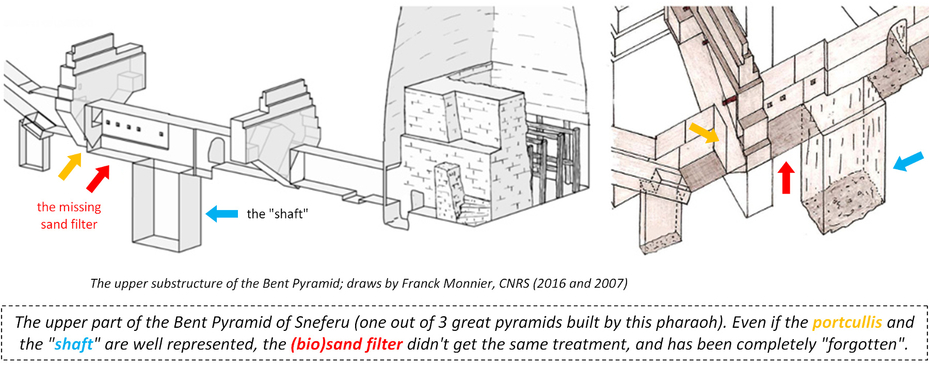
"Vue axonométrique de la chambre supérieure de la pyramide rhomboïdale" by Franck Monnier, CNRS Paris (2016 and 2007): https://www.researchgate.net/figure/The-upper-system_fig4_303024616
Right image: https://fr.wikipedia.org/wiki/Pyramide_rhombo%C3%AFdale
28.18 The forgotten representation of the filter in the Bent pyramid by French CNRS engineer Franck Monnier
The fact that Franck Monnier decided not to draw the filter, isn't unfortunately the first time that the CNRS (the French National Scientific Research Center) engineer took some liberties with archeological interpretations: in Section 14 about the Red Pyramid and the Solvay process, we've already seen that the limestone kiln of the so-called burial chamber, had also suffered the same fate, and that instead of accurately drawing the chamber like it is with the burnt blocks arranged in concentric circles and forming a deep cavity into the floor, Mr. Monnier preferred to reinvent a whole new and flat floor with perfect straight alignments.
I was gonna make some more comments, but who cares; and most of all, what could have Mr. Monnier done different?
Egyptologists simply can't deviate from the official story telling; if they do, they would most certainly lose their accreditations and working visas, or whatever other special authorization one have to get from the local authorities. So, I don't think Franck Monnier, nor any other egyptologist is to blame in the process.

The two Goddesses Anuket-Anukis (at left) pouring water from two water-jars, and Satet-Satis (at right) on their sacred lotus-boat; detail from the ceiling of the Hypostyle Hall of the Temple of Hathor at Iunet. https://www.facebook.com/AmentetNeferetEgyptianReligion/posts/sati-the-great-onethe-lady-of-sunu-syene-aswanthe-eye-of-rathe-lady-of-the-skyqu/3687454131283273/
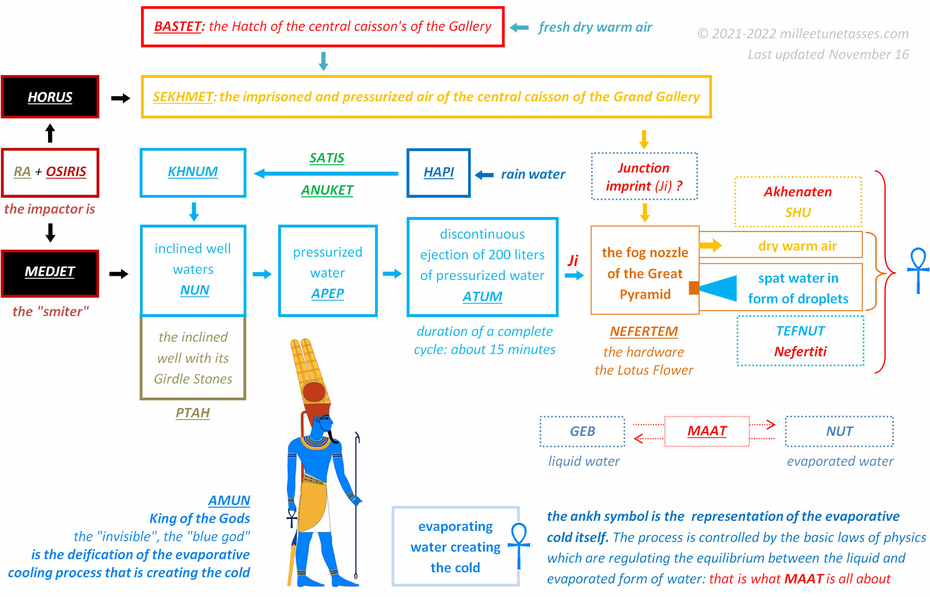
The ancient Egyptian gods and goddesses family tree (last updated November 16, 2022).
The water that powered up the Great Pyramid wasn't coming from the Nile: rainwater harvesting would have allowed to collect enough water into the King's chamber during the appropriate season, and wait until the air would dry enough before using that water before engaging into the evaporative cooling process, also at the appropriate season.
28.19 The First and Second Cataracts are referring to the Sarcophagus input and output "valves"
We've seen that Satis and Anuket are the deifications of the King's chamber releasing valve; but this valve which could have been another portcullis just like the one in the Bent Pyramid, wasn't set in the chamber or just next to it: the first valve, the Satis/Anuket valve was right on top of the biosand filter Sarcophagus of the Great Pyramid.
But there was to be a second valve, one which released the filtered water out of the filter, out of Khnum.
We've also already seen that ancient Egyptians have associated pretty much everything of the Great Pyramid's internal layout with Egypt itself; so we shouldn't be surprised that Satis and Anuket are directly associated with the First Cataract of the Nile, when Khnum is associated with the Second Cataract.
The "First and Second Cataracts" associated with the Elephantine Triad are referring to the input and output valves of the biosand filter Sarcophagus of the Great Pyramid of Egypt.
About rock inscriptions from the Second Cataract forts, Semna and Kumma (Epigraphic Study by Elsa Yvanez. The Sudan National Museum): "A potentially more interesting aspect of the Semna and Kumma corpus is the regular mentioning of local gods. The expression “local gods of Nubia” is even employed in one inscription. Satet “mistress of Eléphantine” is invocated one time, which attest the presence of this goddess of the First Cataract further south. The Nubian god Dedun, related to the inundation, is also mentioned twice. As for the divinised form of the king Senusret III, it represents about 10 % of the religious invocations. The cult of Senusret III in Nubia seems to have developed shortly after his death, as one of the main heritage of the important action of this king in the region (Tallet 2005: 73). But first and foremost, the main god of the Second Cataract was without question Khnum. Invocations to this deity represent about 50 % of the total corpus of private inscriptions from Semna-Kumma. Originally, Khnum was honoured in Elephantine, where he was the warden of the Nile sources and responsible for the river inundations. Because the cataracts were often religiously associated with the sources of the Nile, it seems logical to find Khnum revered at the Second Cataract, mouth of the Nile and entrance door of the river to Egyptian territory."
"Rock Inscriptions from Semna and Kumma, Epigraphic Study by Elsa Yvanez." The Sudan National Museum. Page 13: https://www.sfdas.com/IMG/pdf/rock-inscrip28e2.pdf

Draw of the goddess Anuket by Jeff Dahl: https://en.wikipedia.org/wiki/Anuket#/media/File:Anuket.svg
Emblem of Anuket, discovered in the Satis temple at Elephantine, currently at the Louvre Museum "Emblème d'Anouket, -1295 / -1186(?) XIXe dynastie. Lieu de découverte : Cachette (Éléphantine->Temple de Satet)": https://collections.louvre.fr/en/ark:/53355/cl010007003
Bes amulet from the Metropolitan Museum of Art, New-York: https://www.metmuseum.org/art/collection/search/548299
28.20 Anuket's "plumes" are water plumes (just like Bes)
If active Satis can be compared to the moving stem of a modern valve, inactive Anuket "Who looks like a vagina" would be the cavity of the valve.
In other words, when Satis was moved, water could pass through Anuket; and this is why Anuket has plumes on the head: just like Bes (the wedging block that protected the dormant drain hole of the inclined well), Anuket has been represented with water plumes other the head.
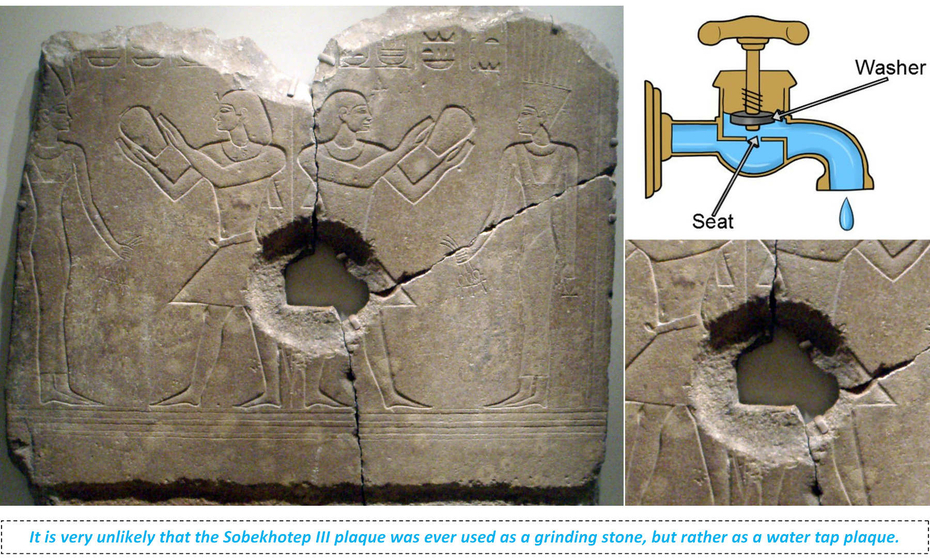
"Sobekhotep III worshipping Satet (left) and Anuket (right). The central hole was made when the relief was used as a grinding stone, long after the original carving. Now on display at the Brooklyn Museum". Photograph by Keith Schengili-Roberts: https://en.wikipedia.org/wiki/Sobekhotep_III
Water tap from: https://www.wonkeedonkeetools.co.uk/tap-reseaters/what-is-a-tap-reseater
28.21 The central hole on the Brooklyn Museum relief was (most probably) for a water tap
It is said about the relief of King Sobekhotep III, that "the central hole was made when the relief was used as a grinding stone, long after the original carving". But apart from the hole itself, there is no other part damaged; would it be possible it was really used as a "grinding stone"?
Could this hole rather be explained by the true meaning of the scene, i.e. the distribution of water?
Personally, I would think that this relief was actually the plaque in which was installed a water tap, with a water tank right behind it, or a simple water pipe.
After all, if both Satis and Anuket are responsible for releasing Hapi's water, and Sobekhotep III is presenting water jars, the only missing part is the water tap so the Sobekhotep III can fill up his jars.
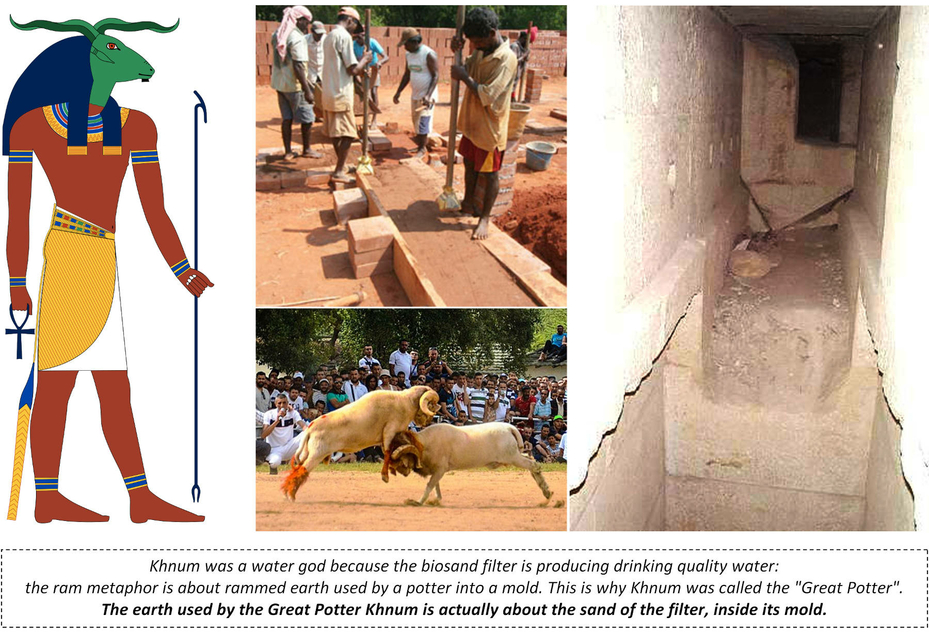
Draw of Khnum by Jeff Dahl: https://en.wikipedia.org/wiki/Khnum#/media/File:Khnum.svg
Ram fighting on Wikimedia Commons thanks to Brahim Djelloul Mustapha: https://commons.wikimedia.org/wiki/Category:Ram_fighting
28.22 The Elephantine Triad: Khnum + Satis + Anuket
We've seen that both Satis and Anuket were the deifications of the valve which controlled the release of the water that was in the King's chamber water tank; but these two deities aren't generally separated from another water god, Khnum, the main deity of the Elephantine Triad and one of the most important gods of all times in ancient Egypt.
Khnum was so important that the full name of pharaoh Khufu, was actually Khnum-Khufu.
28.23 Khnum and the ramming metaphor is about earth ramming
I didn't know what to think of Khnum for a very long time, because of his ram head: for me, the ram metaphor was about the impactor ramming into the inclined well waters, but obviously, Khnum didn't fit the profile of any aspect of the impactor.
Khnum is a water god, and water ramming into water didn't make any sense.
But then, I remembered the mistake I've been doing about snakes: at the beginning of the study I thought they were only the glorification of the pressurized water like Apep or Atum, but I know now that ancient Egyptians used every single particular aspect of every animal they could to represent metaphorically every single aspect of their work.
In other words, one single animal can be used not only in one but in many ways: snakes can be about water, air (Sekhmet, previous Section 27.05) or ropes (Wadjet, Section 25.11).
The thing is that the ram metaphor used with Khnum, is kind of a hybrid one: it really is about ramming, but it is not about the water.
The ram metaphor about Khnum is about ramming the earth, and it is because Khnum is the deification of the biosand filter of the Great Pyramid.
A sand filter, or a biosand filter, is after all nothing less than a "earth filter", where earth, sand and gravels are carefully put into the filter "box".
From a distance both sand and biosand filters look the same, the only difference is that the biosand filter does have a thin layer of living microorganisms which are feeding with most of pathogens that may be present in the water to be filtered. This living layer makes a great difference in the operating of a evaporative cooling system because it reduces drastically the risk of contamination, and makes the entire process way safer than what would do a simple softening sand filter.
28.24 The rammed earth metaphor and the sand of a sand filter
We've seen that this is Satis who is supposed to let the waters of the Nile out of Hapi's cave, but the control of the flood doesn't stop with Satis; there is another "guardian of the flood", and that is Khnum: "The guardian of this flood was Khnemu, and it was he who kept the doors that held it in, and who drew back the bolts at the proper time."
Khnum was a water god because the biosand filter is producing drinking quality water: the ram metaphor is about rammed earth used by a potter into a mold. This is why Khnum was called the "Great Potter".
The earth used by the Great Potter Khnum is actually about the sand of the filter, inside its mold.
"On being told that its waters, the source of all good things, came from a double cavern, which was compared to twin breasts, the king decided to visit the Nile god who watched over the river and emerged at the time of the flood. The gatekeeper of the flood was Khnum God, who guarded the doors that kept the water in and then, at the right moment, threw open the doors to let the floods loose on the land." https://www.egy-king.com/2021/08/egyptian-god-of-water-khnum.html
The Auroville Earth Institute (AVEI) is a non-profit organization specializing in the research, development, promotion and transfer of earth-based building technologies, among the most cost effective, low carbon, low embodied energy solutions for sustainable development. https://www.earth-auroville.com/sre_foundations_en.php
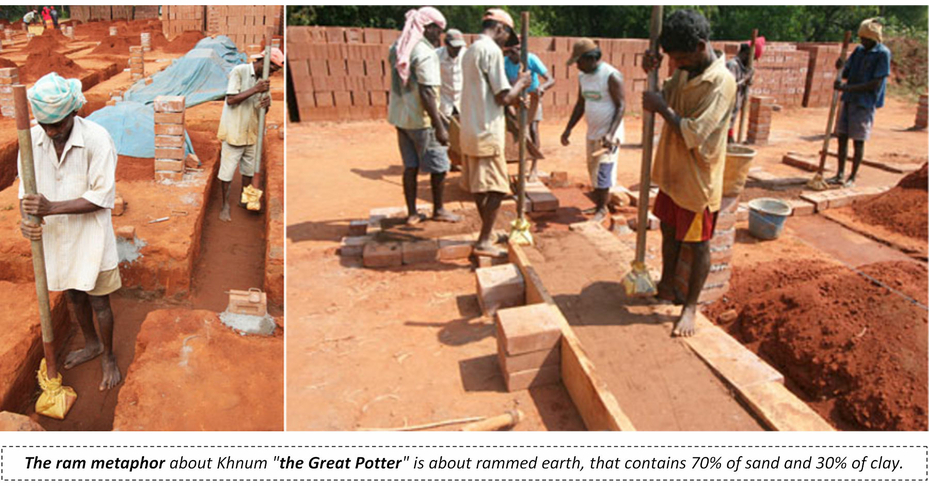
The Auroville Earth Institute (AVEI) is a non-profit organization specializing in the research, development, promotion and transfer of earth-based building technologies, among the most cost effective, low carbon, low embodied energy solutions for sustainable development. https://www.earth-auroville.com/sre_foundations_en.php
28.25 Rammed Earth requires 70% sand in the soil, and 30% of clay
"Rammed earth, building material made by compacting certain soils, used by many civilizations. The most durable of the earth-building forms, rammed earth may be used for making building blocks or for constructing whole walls in place, layer by layer. In making building blocks, the soil is rammed into a box-shaped mold. In building up whole walls, two wooden planks separated by a spacer bolt are used as a form, and the earth is rammed into this in layers; when the form is filled, it is removed and superimposed on the top of the wall and more earth is rammed in until the desired height is reached. Ironheaded rammers, roller-mounted forms, pneumatic rammers, and hydraulic, mass-production block presses have been used. The soil used must be high in sand and low in clay, 70 percent and 30 percent being the usual proportions. About 10 percent water is added in modern practice. Good compressive strength is characteristic of rammed earth." https://www.britannica.com/technology/rammed-earth

Ancient Egyptian water god Khnum as Cnouphis-Nilus (Jupiter-Nilus, Dieu Nil), N372.2, at the Brooklyn Museum. Draw by Léon-Jean-Joseph Dubois: https://en.wikipedia.org/wiki/Khnum#/media/File:Cnouphis-Nilus_(Jupiter-Nilus,_Dieu_Nil),_N372.2.jpg
"Ram Pokherai drinks clean water from his family's biosand filter. Clean water helps children stay healthy, which means they are less likely to need time away from school, so their education improves. Providing clean water has important knock-on effects." Courtesy of Editorial, Humanitarian & Travel Photographer Gavin Gough : https://www.gavingough.com/clean-water-in-rural-nepal
Images from this assignment are being used to raise awareness of the important work that Centre for Affordable Water and Sanitation Technology, CAWST is doing, providing the resources and education required for reliable clean water supplies in rural areas. https://www.cawst.org/
28.26 Khnum is indeed associated with potable potent water
Not only Khnum ensured that the "right amount of silt" was released in the Waters of the Nile during the inundation [1], which can be interpreted as the right amount of sand and its proper layout inside the filter, but it turns out that Khnum is indeed associated with drinking water [2].
The only way that the waters of the inundation of the Nile could be associated with drinking water, is that you somehow purify that water. It means that Khnum is really about water filtration.
[1]: "The Egyptians believed that he was the guardian of the source of the Nile who was originally a Nile god, but who became a helper of Hapi. His role changed from river god to the one who made sure that the right amount of silt was released into the water during the inundation. In working with the silt, the very soil that the ancient Egyptian potters used, he became the great potter who not only molded men and women, but who molded the gods themselves and the world." http://www.touregypt.net/featurestories/khnum.htm
[2]: There is an excerpt that is talking about the fact that Khnum is not associated with any kind of water, but with potable water. Source: Ember Elektra http://chthonickore.blogspot.com/2020/07/hes-magic-man.html
"His [Khnum] name in hieroglyphics also points to his early role as a water god. In hieroglyphics "Khnum" is written with a "water jug" pictogram representing the phonogram ẖnm (khnum).
As a primeval god, this water jug is a symbol of greater importance than it may first appear. Remember the heavens themselves were described and imagined as water/s and the gods were shown traveling these "waters" in barques. The Milky Way was sometimes described as the "Nile in the sky." So the dramas that played out in the sky with the sun and stars were reflective and analogous of happenings below on earth. Just as the importance of the fertile fresh waters of the Nile were known to the Egyptians to be essential for abundance and life, so too, the gift of water from heaven was understood as it pertained to the spiritual life and provided life and health to the body.
Not all water/drink is equal, however. Water can be stagnant or fresh. The best water is that which is the cause of health, fertility, rejuvenation, and life. This water of life or living water is a gift. Khnum represented the powers of these potent regenerative waters of life supplied to the world in the form of this vessel or pot.
Potent is from Latin potentem (nominative potens) "powerful," present participle of *potere "be powerful, able, capable." Khnum was most definitely then a Potere (powerful) Potter and pater ("father" in Latin) of the gods and humans. The ultimate PIE root of potent is said to be *poti- "powerful; lord".
These potent waters are most potable as well. Potable is not immediately and obviously connected to this concept of "potent" itself. It comes from a word meaning "to drink". Potable is from Old French potable (14c.), and directly from Late Latin potabillis "drinkable," from Latin potare "to drink" (from PIE root *po(i)- "to drink").
We see a noun form of the word potare "to drink" used here in the Vulgate, caro enim mea vere est cibus et sanguis meus vere est potus [for my flesh is true food and my blood is true drink.] John 6:56
It's not crazy to think that these concepts are somehow related, however, namely the symbol of the potent potter, i.e., a pot (of sorts), and what is in the pot, i.e., drink (potus); potent, pot, potable. Khnum is a Poti (Powerful Lord) of the powerful/potent potus (drink).
The etymology of the word "pot" is said to be of uncertain origin, however. Nevertheless the concept of pot (a thing which holds liquid/drink) and drink (potare/potus) in this case are easily related in their association with this god (Khnum). The fact that the Divine Potter is intimately connected to both a vessel (pot) and water (and remember the hieroglyph for water [three wavy lines] also can have the meaning "to drink") lead to the consideration that the word "pot" and certain words for drink might ultimately be connected to the notion of things related to this powerful/potent god." http://chthonickore.blogspot.com/2020/07/hes-magic-man.html
28.27 The distinction between "potable" and "drinking" water
It is also interesting to note that if "potent" is about "potable" water, it doesn't imply that this water is meant to be "drinking" water: it is just saying that you can drink it; and that its purity is so good that you can drink it, even if it is not supposed to be drunk at all. And that is the perfect description of the quality of the water produced by the biosand filter of the Great Pyramid.
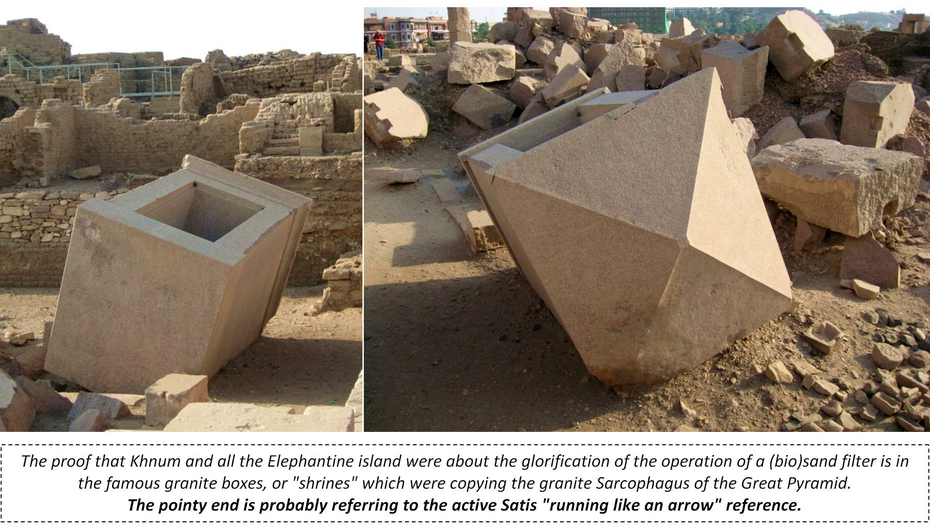
Granite shrines "boxes" in the Temple of Khnum, Elephantine island (Aswan): http://www.sacredsitesjourneys.com/Egypt-PhotoGallery-3.htm
28.28 The Elephantine granite "shrines"
The proof that Khnum and all the Elephantine island were about the glorification of the operation of a (bio)sand filter is in the famous granite boxes, or "shrines" which were copying the granite Sarcophagus of the Great Pyramid. The pointy end is probably referring to the active Satis "running like an arrow" reference.
Very interesting video, with people inside one of the granite boxes that is about 2 meters deep: https://www.youtube.com/watch?v=fhWiUad1gOQ

28.29 When Khufu becomes Khnum-Khufu... and Khafre becomes Ra-Khafre
One of the difficult parts of deciphering ancient Egyptian gods and deities, is that everything happened over many years and generations of experimental work, step after step, starting (most probably) with the very first Dynasty, or even before that. The Great Pyramid concentrates most of these deities, because she was (most probably) the final outcome of the whole thing; but some of them are very old deities, and Khnum is one of them.
Most probably Khnum, was at the very beginning referring to a "simple" sand filter, that became other the years a biosand filter when the functioning of the biofilm of living microorganisms would have been mastered.
What is interesting is that Khufu's full name was actually Khnum-Khufu; and if you add this to the (bio?) sand filter of his father's Bent Pyramid, a possible scenario is that this added part of Khufu's name would be a simple reference to the latest innovation of his time, i.e. the latest innovation of his father's.
So, when Khnum-Khufu build his Great Pyramid after having mastered the floating composite impactor operation Ra, his own son Khafre will add this Ra name to his own, and become known as Ra-Khafre.
"Khnum (Khenmew, Khnemu, Khenmu, Chnum), from the Egyptian 'unite', 'join' or 'build', was an ancient deity of fertility, water and the great potter who created children and their ka at their conception. He was mentioned in the pyramid texts and the pyramid builder Khufu's name was actually 'Khnum-Khufu' meaning 'Khnum is his Protector'. His cult was popular before the cult of Re eclipsed it. The next pyramid builders were his son and grandson who added 'Re' to their names - Khafra and Menkaura. Khnum was possibly even a predynastic god. The Egyptians believed that he was the guardian of the source of the Nile who was originally a Nile god, but who became a helper of Hapi. His role changed from river god to the one who made sure that the right amount of silt was released into the water during the inundation. In working with the silt, the very soil that the ancient Egyptian potters used, he became the great potter who not only molded men and women, but who molded the gods themselves and the world." http://www.touregypt.net/featurestories/khnum.htm
"Khufu's name was dedicated to the god Khnum, which might point to an increase of Khnum's popularity and religious importance. In fact, several royal and religious titles introduced at this time may point out that Egyptian pharaohs sought to accentuate their divine origin and status by dedicating their official cartouche names to certain deities. Khufu may have viewed himself as a divine creator, a role that was already given to Khnum, the god of creation and growth. As a consequence, the king connected Khnum's name with his own. Khufu's full name (Khnum-khufu) means "Khnum protect me". While modern Egyptological pronunciation renders his name as Khufu, at the time of his reign his name was probably pronounced as Kha(w)yafwi(y), and during the Hellenized era, Khewaf(w). [...] "The pharaoh officially used two versions of his birth name: Khnum-khuf and Khufu. The first (complete) version clearly exhibits Khufu's religious loyalty to Khnum, the second (shorter) version does not. It is unknown as to why the king would use a shortened name version since it hides the name of Khnum and the king's name connection to this god. It might be possible though, that the short name wasn't meant to be connected to any god at all." https://en.wikipedia.org/wiki/Khufu

Elephant spraying water at the Sanctuary for Rescued Elephants in Pattaya, Thailand: https://www.pattayaelephantsanctuary.org/gallery/
Desert elephant (Loxodonta africana) spraying sand on herself while guarding her sleeping baby. She has covered the baby with a branch. Damaraland, Namibia. Photograph by Charles J. Sharp: https://fr.wikipedia.org/wiki/%C3%89l%C3%A9phant_du_d%C3%A9sert#/media/Fichier:Desert_elephant_(Loxodonta_africana)_spraying_sand.jpg
28.30 The Elephant metaphor is about both water and earth
Many hypothesis are trying to explain why the Elephant has been associated with the Khnum, Satis and Anuket Triad by naming Elephantine Island just like it is; but when you know that this Triad is all about a sand filter, that is purifying water, simply using earth, the elephant metaphor becomes perfect because an elephant spraying water or earth on himself is without any doubt the first image that comes to mind about an elephant.
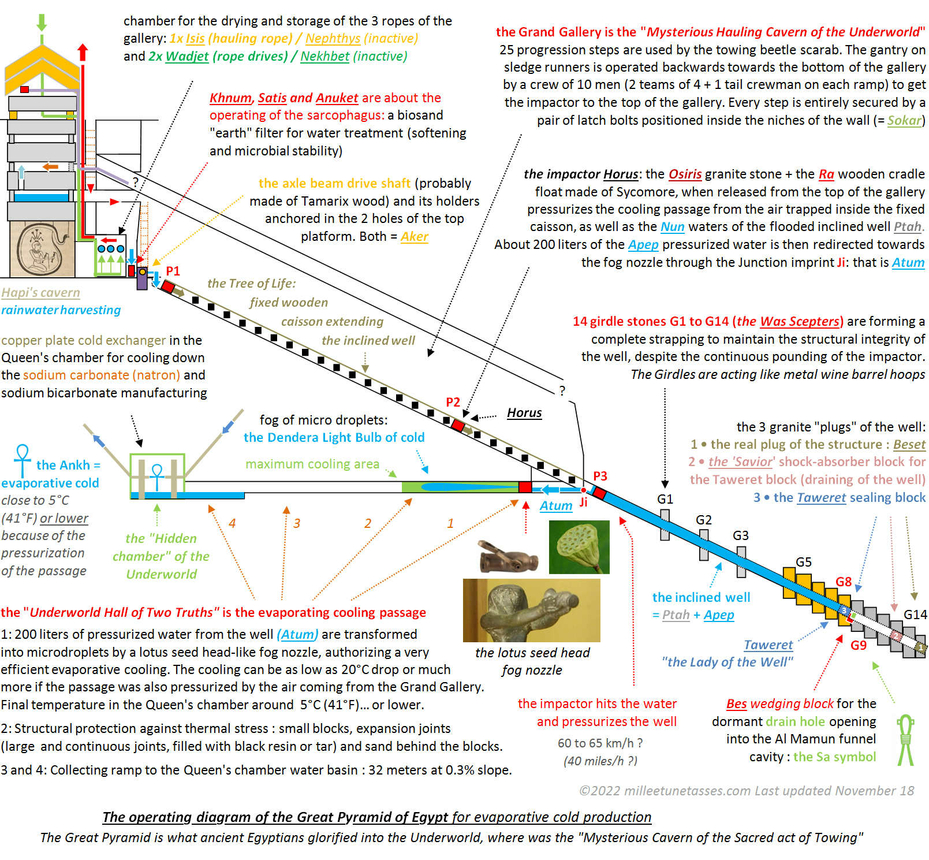
The operating diagram of the Great Pyramid of Egypt for evaporative cold production. The Great Pyramid internal layout is what ancient Egyptians glorified into the Underworld, where was the "Mysterious Cavern of the Sacred act of Towing". Last updated November, 18.
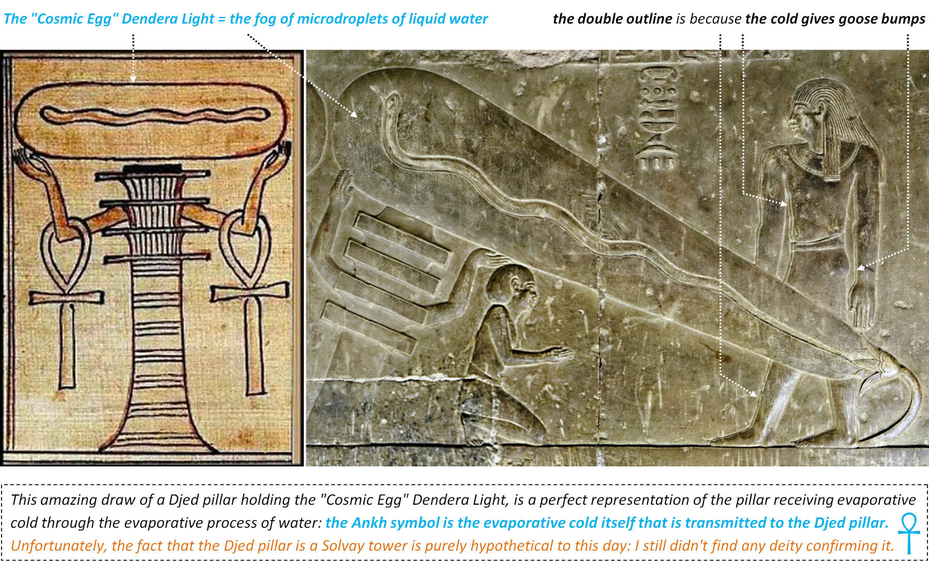
More on the Dendera Light in Section 2: the evaporative cooling process and the Dendera Light
28.31 Is the Solvay process just a fad?
I must admit that this whole ancient Egyptian deities deciphering thing has become kind of a "supreme game" that I really enjoy, maybe because it is a way to get as close as possible to the true nature of ancient Egyptian themselves; but I have a major problem: until today, I've found no real indisputable clue that the evaporative cold was created to cool down chemical manufacturing of sodium carbonate natron. I've found not a single god or goddess directly referring to the Solvay process.
I'm not saying I have to invalidate this part of the study, because maybe it is right under my eyes and I just don't see it, or maybe this part simply didn't get the same treatment than the evaporative cold.
One of the keys of the study is the dual active and inactive "philosophy" that ancient Egyptians loved to oppose, in some ways; maybe they did that in a broader scale by glorifying everything about Physics (how was produced the cold) and nothing about Chemistry, like this part was the real end game which nobody could ever understand in any way.
In every single temple, there was a place where only the highest ranking priests were allowed to go, maybe this sacred place was all about Chemistry.
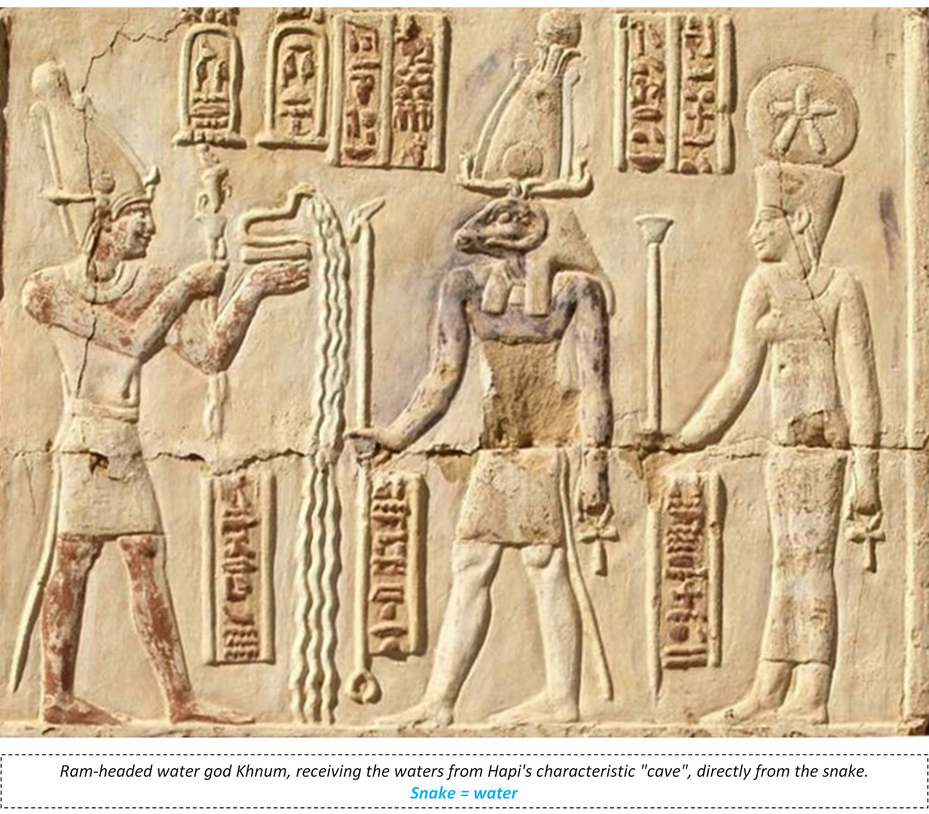
Source: https://i.pinimg.com/originals/65/fe/f0/65fef06826d4663ed468653119a370b9.jpg
28.32 Summary of the study: hidden behind the academic vision of the ancient Egyptian religion, a vast number of metaphors are describing some of the most advanced science and technological knowledge of that time : ancient Egyptian gods were nothing else than pharaohs' metaphoric self-glorifications of their theoretical and experimental scientific accomplishments in physics and chemistry.
Pharaohs used the power of Science to legitimate themselves as kings of Egypt : they forged an entire religion, based on science to rule their kingdom, and they presented that science as Magic.
The end game of this technological program that probably started on the very first Dynasty, was the Great Pyramid of Giza where evaporative cooling was engineered in the known part of the pyramid from the pressurized water produced in the inclined well, known today as the ascending passage.
The evaporative cold simply took advantage of the power of water, and was most probably necessary to cool down chemical manufacturing of sodium carbonate and sodium bicarbonate produced by an ammonia-soda Solvay process, as suggested by the very strong ammonia smell and the limestone kiln in the so-called burial chamber of the Red Pyramid. At that time, sodium carbonate was called natron, and it was the salt used for the mummification of the pharaohs (Sections 14, 15 and 16).
The cooling seems to have represented the most difficult part of the process, as suggested by the Step Pyramid's official name : according to scholars, the very first pyramid complex, the Step Pyramid of Djoser, was called "the refreshment of the Gods". No doubt that a more accurate translation would certainly be "the cooling of the Gods".
It means that ancient Egyptians were the first civilization to master a Solvay-like process for sodium carbonate manufacturing, long before it got reinvented in the 1800's in Europe. The key elements of that process is the temperature control of the chemical reactions (the cooling), and the dome shaped plate necessary for the counterflow chemical reactions to occur in an efficient way. That counterflow reaction plate is what really is the disc of Sabu.
As shown with Akhenaten and Nefertiti, the creation of the evaporative cold was the most sacred accomplishment of all (Section 17), and this is exactly what the Dendera Light is all about : the Dendera Light is the fog of microdroplets of liquid water that evaporates and creates the cold. Talking about the snake inside the Dendera Light Bulb : "The field surrounding Ra’s snake form is referred to in ancient Egyptian literature as protective magical energy in liquid form that all gods and pharaohs possess" (Faulkner, Section 2).
Everything that had been done in the Great Pyramid of Giza inspired most of the ancient Egyptian religion, and it had been glorified into what we know today as the Underworld.
The Underworld is referring to the chambers and passages of the Great Pyramid of Khufu, and in particular to the Grand Gallery where a hauling gantry beetle operated a wooden coffin shaped impactor that had a small nested granite block inside it. The impactor generated endlessly, over and over, maybe every 15 minutes the pressurized water that was then transformed into a fog of microdroplets inside the horizontal cooling passage.
The Grand Gallery of the Great Pyramid where the act of hauling was done, is the "Secret Hauling Cavern of the Underworld" described in the Amduat "Book of the Hidden Chamber".
The most important chamber of the Great Pyramid wasn't the King's chamber that only was the main water tank of the pyramid, but the Queen's chamber, the only one on the central axis of the pyramid. Because the Queen's chamber was inaccessible from the rest of the pyramid, it was glorified into the "Hidden Chamber of the Underworld" (Section 11), and because the Queen's chamber was the coolest place in the pyramid (about 5°C / 41°F), and with a constant 100% Humidity rate, this chamber was the one where the biggest amount of very hard salt encrustation had been documented by the first explorers of the pyramid in the 1800's and before it had been removed in 1998 by Zahi Hawass (Section 1). Very hard salt encrustation is the signature of the evaporative cooling process, even nowadays.
The most incredible thing is that pretty much everything I've just said, actually appears in many myths, and they don't even originate from ancient Egypt : the "Churning of the Ocean" Hindu myth that produces the immortal nectar Amrita, the Tibetan Prayer Wheels operated to give small amounts of 'merit' to too lazy Naga snakes, and the entire Norse mythology with Thor's magical hammer endlessly fighting another Great Serpent of the Underworld and producing a mist of cold from a mysterious well that would be opposed to hellishly hot heat waves.
I'm talking a lot about the impactor of the Great Pyramid, but it is nothing compared to the tremendous impact caused by what the ancient Egyptians had accomplished within the 78 years of the Great Pyramids Era, from Djoser to the Great Pyramid: the entire ancient World had been shaken up in their deepest beliefs beyond all comprehension; and we are still talking about it today.
Superb Ancient Egyptian Engineering Analysis
Sir, I've loved ever bit of your evidence-based explanations for the ancient Egyptian pyramids (to include the political and allegorical usage of their gods as science). With complete humility and honesty, you've created the most exposing website I've ever seen on this subject. For your most recent enquiry (regarding which god represents the Solvay process), couldn't it be the god of mummification himself, Anubis?
He is the god of death, mummification, embalming, the afterlife, cemeteries, tombs, and the Underworld.
As the embalmer of the deceased, he appears to embody the Solvay process itself.
Am I completely off target?
Your work continues to astonish in its simplicity.
Thank you,
Ben
Bruno
Thank you very much for your comments, Ben. It is true that until today, every new deity deciphering of the engineering part of the cold production, pointed to another one, and another one, over and over. But in order to resolve the question of why was produced the cold, we need to get off these tracks and try another approach. I haven't really worked on Anubis yet, but maybe he is the key. I'll try to work on him, probably in January as December is always a very busy month. Best regards, Bruno.
Poster un commentaire
